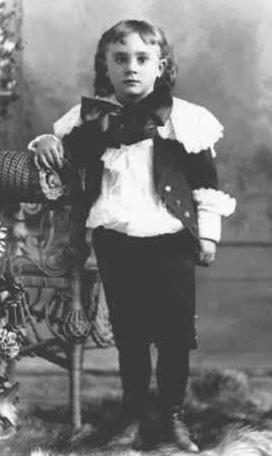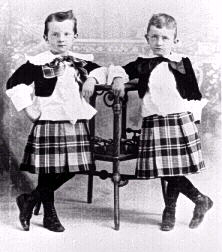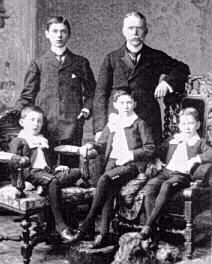Figure 1.--.

|
Figure 1.--. |
Fauntleroy suit styles varied considerably with a great variery of
patterns available to the discerning,
fashion conscious mother. As most available photographs only show the
front of the jacket, we mostly know about the back from designs published
on The Delineator and other publications. Jackets were often
shaped at the back with a curving center seam.
Many jackets had side pockets at the front and were closed at the front
with button-holes and buttons. Some were designed not to be closed to
better show elaborately lace trimed blouses. Some jacket had slits cut
at the back.
Fauntleroy suits were made in many colors and materials and with a variety of features and embelishments.

Figure 2.--This American from Boston wears a classic Fauntleroy suit. Note the small jacket and large lace collar. He wears his suit with a large colored bow. |
The classic Fauntleroy suit was black or dark blue. Later other dark
colors appeared like burgandy or forrest green. We know suits were made
in these colors because many wealthy families had portraits painted.
Also fashion magazines during the period noted these
colors, notably the velvet suits were usually dark colors. The suits
done in satin, however, were usually lighter colors.
Color is an interesting
topic. We know that Fautleroy suits were made in black and the above
noted dark colored velvets. What is not known, however, is the relative
popularity of the different colors. I had assumed that the black suits
were the primary colors. This is probably because I was viewing the
photographic record which was, of course, all black and white photography.
I know of no historical works discussing this question. Available
sources of information at this time provide the following
information on color:
The 1880s: A painting by Millais on loan during 1998 to a London
Museum shows Master
Robert Rankin who looks to be about 10 or 11 years in an elaborate
forrest green velvet Fautleroy suit with lace collar
and cuffs, long uncvurled hair, and a beret-like cap.
The 1890s: A 1896
Sargent portrait shows an American family, Mrs. Carl Meyer and her children, with the boy wearing a grey Fauntleroy suit.
Fauntleroy suits were primarily velvet suits. Some fancy suits
were made of satin, but these were much less common than the velvet
suits. The bettere suits were usually lined
with silk and worn with cambric blouses. Other less expensive suits were
made for mothers of more modest means from serge, flannel, and a variety
of other cloths. Most of these materials are solid colors, but Fauntleroy
suits were also made of patterned material. Many of the patterned fabrics
appear to be lighter weight materials for summer wear.
The suits at first had pants or trousers cut at or below the knee. The most common style had pants which reached a little below the knees.

Figure 4.--Fauntleroy suits were also worn with bodice skirts and Scotch plaid kilts like these brothers. Note the large lace-trimed blouses covering much of the velvet jacket. |
The trousers were attached to the blouse by means of buttons
and button-holes to a cambric shirt-waist or blouse. Some fancy suits
had bows at the closure.
Some boys were dressed in a typical Fautleroy jacket and lace collar,
but with a kilt or frock instead of
kneepants. The kilt was rarely
a Scottish plaid, but made of the same material as the
jacket. This fashion gave the apearance of a dress rather than a
Scottish kilt. The Fauntleroy suit dress/kilt was particularly popular
in the
1880s and early 1890s, but declined as the new century approached and
the fashion of dressing small boys in dresses wained.
The skirted Fauntleroy suits were generally for the younger boys.
Some particularly doting mothers, however, decided to dress
their older boys in a kilted Fautleroy suit, consisting of a lacey blouse
and collar, and velvet jacket, just like the traditional Fauntleroy suit.
The only difference was a kilt instead of kneepants. In such instances,
the outfit of the
older boy would
generally be a plaid kilt looking like an actual Scottish
kilt rather than the solid color kilt suits worn by the younger boys.
Apparently, it was more acceptable for an older boy to wear an actual
Scottish kilt than the more juvenile kilt suits where the jacket and skirt
were made of the same material.
The classic Fauntleroy suit had several distinguishing features:
Lace collar: The most distinguishing fearture of any Fauntleroy
suit was the elaborate lace collared blouse. As many Fauntleroy suits

Figure 5.--These three brothers, despite the differences in ages, wear identical Fauntleroy suits with black stockings. Note the buttons at the hem of the knee pants. |
Some of the early suits also had
lace at the hem of the knee length pants, but this was relatively
rare.
Many Fauntleroy suits had extensuve embroidery. This is often
difficult to see in most of the available phorographs.
Fauntleroy Related Pages:
Returnt to main[Fauntleroy page]
[Edwardian Fauntleroy suits]
[Final Fauntleroy period]
[Fauntleroy dresses]
[Lace collars]
[Vivian Benett]
[Fauntleroy patterns]
Other Related Pages:
[Dresses]
[Kilts]
[Smocks]
[Pinafores]
[Sailor Hats]
[Blouses]
[Ring Bearers]
[Long hair]
[Ringklet curls]
[Hair bows]
[Bangs]
[Collars]
[Bows]
Navigate the Boys' Historical Clothing Web Site:
[Return to clothing styles]
[Introduction]
[Chronology]
[Biographies]
[Bibliographies]
[Activities]
[Countries]
[Contributions]
[Boys' Clothing Home]
